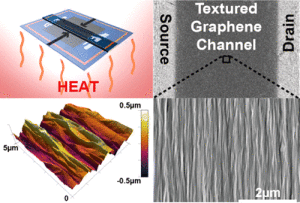
The researchers are also investigating the textured graphene surfaces for 3D sensor applications.
Image: Nano Letters
The infamous wonder material is becoming even more wonderful with this new development from the University of Illinois at Urbana-Champaign (UIUC).
Scientist from UIUC have developed a novel process to transform flat graphene from 2D to 3D with a simple and commercially available single-step process. The process uses thermally activated shape-memory polymer substrates to texture the graphene and “crumple” it to give it an increased surface space.
With the easy of this process and the increased surface space of the material, there is a potential for electronics and biomaterials to advance at a much faster rate.
“Fundamentally, intrinsic strains on crumpled graphene could allow modulation of electrical and optical properties of graphene,” explained SungWoo Nam, an assistant professor of mechanical science and engineering at Illinois. “We believe that the crumpled graphene surfaces can be used as higher surface area electrodes for battery and supercapacitor applications. As a coating layer, 3D textured/crumpled nano-topographies could allow omniphobic/anti-bacterial surfaces for advanced coating applications.”
The new development further promotes graphene as the prime material for next generation optoelectronics, electromechanical, and biomedical applications.
According to the scientists, the whole processes is low cost and can be achieved with ease – allowing graphene to create even more sensitive and intimate interactions with biological systems, leading to high sensitivity devices.
Read the full paper, “Heterogeneous, Three-Dimensional Texturing of Graphene,” here.
Want to learn more about graphene? Head over to the Digital Library to read our most recent papers on the wonder material.
And don’t forget to sign up for our free e-Alterts and RSS Feeds!

